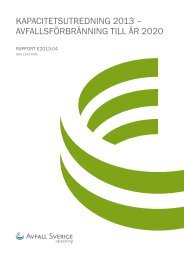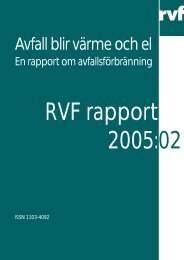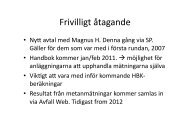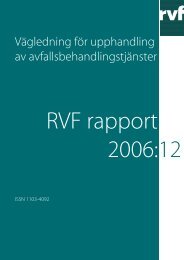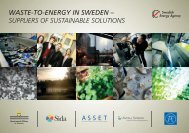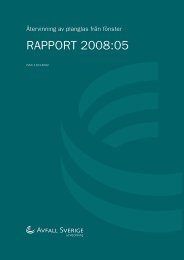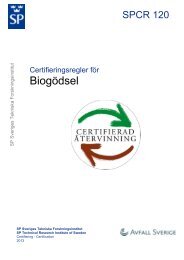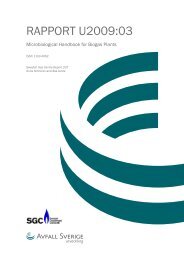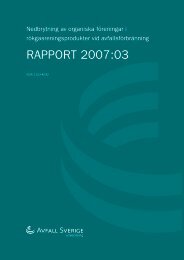Smittspridning via kompost och biogödsel från ... - Avfall Sverige
Smittspridning via kompost och biogödsel från ... - Avfall Sverige
Smittspridning via kompost och biogödsel från ... - Avfall Sverige
You also want an ePaper? Increase the reach of your titles
YUMPU automatically turns print PDFs into web optimized ePapers that Google loves.
Summary<br />
Large-scale activities for composting and biogas production are currently increasing in the<br />
Nordic countries. In Sweden, the amount of organic waste that was treated by these processes<br />
was in 2003 around 400 000 tonnes. This number may increase considerably in a few years,<br />
partly as a result of the prohibition of putting organic waste on landfills that applies from the<br />
turn of the year 2004-2005. Depending on the source of the waste, a wide spectrum of<br />
disease-causing microorganisms may be present in the material that is to be treated within the<br />
plants. This has lead to various restrictions and measures of safety, partly through legislation<br />
on the national and international level, and partly through voluntary undertakings. Through<br />
the system for certification, the Swedish National Testing and Research Institute (SP) today<br />
administers a proper operation of the large-scale biogas plants, and the certification thereby<br />
functions as a tool to manage the risks for, among other things, transmission of disease.<br />
A large number of different infectious agents (pathogens) may potentially be present in<br />
organic waste. Foodstuffs and raw materials may through inadequate hygienic handling be<br />
contaminated, and it is calculated that a far greater number of food poisonings than what is<br />
reported by the statistics occur in Sweden, which illustrates the presence of pathogens in food<br />
waste. Smaller amounts of excreta from humans and animals may enter the plants <strong>via</strong><br />
household waste, and constitutes thereby a risk for disease transmission that need to be<br />
considered. Animal manure is also present in the incoming material, and in the biogas plants<br />
abattoir waste is also treated. Thereby may animal pathogens enter the plants, even if it is<br />
counteracted by existing legislation. Garden waste that in itself is free of pathogens may be<br />
contaminated by, for example, excreta from animals.<br />
By composting and anaerobic digestion organic material is stabilised through decomposition,<br />
whereby the volume decreases. The treatment processes also sanitise the organic material.<br />
Proper temperature during a sufficient time period is considered to be of most importance for<br />
the inactivation of infectious agents. In plants for anaerobic digestion of manure and abattoir<br />
waste, pasteurisation at +70°C during 1 hour is demanded, which substantially reduces the<br />
occurrence of pathogens. Even if pasteurisation precedes the main process, the final product<br />
may be sensitive to reinfection and regrowth, which means that bacteria may grow in the<br />
material from an initially low concentration. It is therefore of great importance that the<br />
following handling, transport and possible storage is performed in a hygienically safe manner.<br />
For composting, conditions for temperature and time are recommended by the Swedish EPA.<br />
Covering of the compost decreases the risk for exposure to humans and animals, and will also<br />
give a more even temperature and thereby a safer sanitisation. Composting in the thermophilic<br />
temperature range (>50°C) normally gives a hygienically safe product.<br />
Selection of incoming material, process requirements and restrictions for handling and use of<br />
the products are measures that presently limits the risks for disease transmission through<br />
legislation, regulations and voluntary undertakings. The intention is to keep the occurrence of<br />
pathogens on a level where the use of compost and residues from digestion (bio-fertilizer) do<br />
not result in an increase in disease cases in society. Naturally, something in the process may<br />
malfunction and it is also possible that this is not discovered by the existing control system.<br />
Therefore, it can not be excluded that pathogens may end up in the environment by the use of<br />
compost and bio-fertilizer, but the probability of significant concentrations of pathogens being<br />
present must be estimated to be low. In addition to sufficient control of the complete handling<br />
chain, for example by the system for certification, it would be desirable that quality<br />
parameters for compost and bio-fertilizer are further developed.<br />
5





